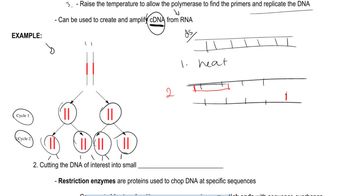Table of contents
- 1. Introduction to Genetics51m
- 2. Mendel's Laws of Inheritance3h 37m
- 3. Extensions to Mendelian Inheritance2h 41m
- 4. Genetic Mapping and Linkage2h 28m
- 5. Genetics of Bacteria and Viruses1h 21m
- 6. Chromosomal Variation1h 48m
- 7. DNA and Chromosome Structure56m
- 8. DNA Replication1h 10m
- 9. Mitosis and Meiosis1h 34m
- 10. Transcription1h 0m
- 11. Translation58m
- 12. Gene Regulation in Prokaryotes1h 19m
- 13. Gene Regulation in Eukaryotes44m
- 14. Genetic Control of Development44m
- 15. Genomes and Genomics1h 50m
- 16. Transposable Elements47m
- 17. Mutation, Repair, and Recombination1h 6m
- 18. Molecular Genetic Tools19m
- 19. Cancer Genetics29m
- 20. Quantitative Genetics1h 26m
- 21. Population Genetics50m
- 22. Evolutionary Genetics29m
18. Molecular Genetic Tools
Genetic Cloning
Problem 24a
Textbook Question
Textbook QuestionHow would you clone a gene that you have identified by a mutant phenotype in Drosophila?
 Verified Solution
Verified SolutionThis video solution was recommended by our tutors as helpful for the problem above
Video duration:
1mPlay a video:
Was this helpful?
Key Concepts
Here are the essential concepts you must grasp in order to answer the question correctly.
Gene Cloning
Gene cloning is a molecular biology technique used to create copies of a specific gene. This process typically involves isolating the gene of interest, inserting it into a vector (like a plasmid), and introducing this vector into a host organism, where it can replicate. Understanding the steps of gene cloning is essential for manipulating genetic material effectively.
Recommended video:
Guided course

Positional Cloning
Drosophila as a Model Organism
Drosophila melanogaster, commonly known as the fruit fly, is a widely used model organism in genetics due to its short life cycle, ease of breeding, and well-mapped genome. Studying mutant phenotypes in Drosophila allows researchers to identify and analyze specific genes responsible for traits, making it a valuable tool for genetic research and gene cloning.
Recommended video:
Guided course

Drosophila P Element
Mutant Phenotype Identification
Identifying a mutant phenotype involves observing and characterizing physical or behavioral changes in an organism that deviate from the wild type. This process is crucial for pinpointing the genetic basis of traits, as it helps researchers focus on specific genes that may be responsible for the observed mutations, guiding the subsequent cloning efforts.
Recommended video:
Guided course

Mutations and Phenotypes

 7:43m
7:43mWatch next
Master Genetic Cloning with a bite sized video explanation from Kylia Goodner
Start learningRelated Videos
Related Practice


